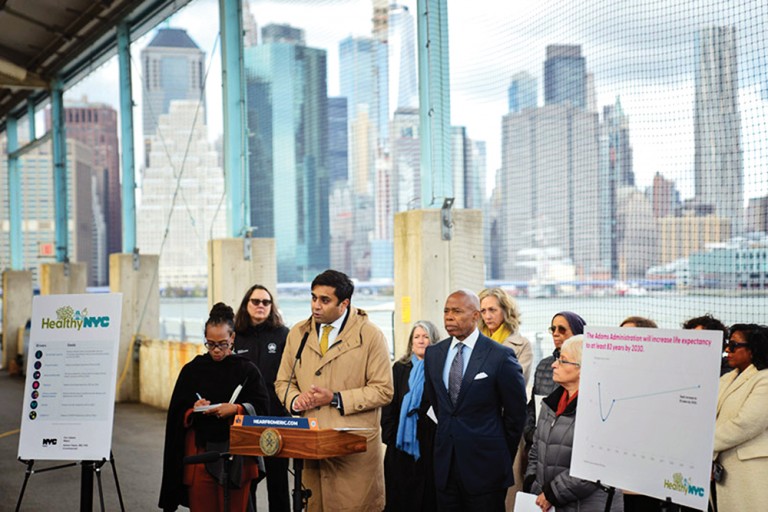By Forum Staff
Mayor Eric Adams and City Department of Health and Mental Hygiene (DOHMH) Commissioner Dr. Ashwin Vasan recently unveiled “HealthyNYC,” a plan to improve and extend the average lifespan of all New Yorkers.
The campaign sets ambitious targets to address the greatest drivers of premature death, including chronic and diet-related diseases, screenable cancers, overdose, suicide, maternal mortality, violence, and COVID-19. Overall, the campaign aims to extend the average life expectancy of New Yorkers to 83 years by 2030, with gains across racial and ethnic groups.
The “HealthyNYC” plan aims to address the life years lost during the COVID-19 pandemic to the virus and other causes and surpass life expectancy from what it was pre-pandemic. Between 2019 and 2020, overall life expectancy across demographics fell to 78 years. Recent data suggests that life expectancy in New York City has begun to improve, with 2.7 years gained back from 2020 to 2021, however life expectancy remains well behind 2019 data. These impacts have also not been felt equally, as life expectancy fell to 76.1 years among Black New Yorkers in 2021, compared to 81.8 years among white New Yorkers.
While COVID-19 was the biggest driver of the decrease in life expectancy in 2020, other causes contributed to this decline, both locally and nationally. For example, overdose deaths increased in 2020 and 2021. Other drivers of decreasing lifespans included gun violence and chronic diseases, like diabetes. To address this trend, “HealthyNYC” outlines the following ambitious goals:
Reduce cardiovascular disease and diabetes by 5 percent by 2030;
Reduce screenable cancers — including lung, breast, colon, cervical, and prostate cancers — by 20 percent by 2030;
Reduce overdose deaths by 25 percent by 2030;
Reduce suicide deaths by 10 percent by 2030;
Reduce homicide deaths by 30 percent by 2030;
Reduce pregnancy-associated mortality among Black women by 10 percent by 2030; and
Reduce annual COVID-19 deaths by 60 percent by 2030.
By reaching these milestones, the city can bring life expectancy above 83 years by 2030 and reduce existing racial disparities in life expectancy. The city will employ a number of strategies to achieve these reductions in deaths, including:
Increasing access to naloxone, proven harm-reduction, and treatment and recovery centers to reduce overdose deaths;
Expanding access to culturally responsive mental health care and social support services, including early intervention for communities of color and LGBTQIA+ youth and address the impact of social media on youth mental health and suicidal ideation to reduce suicide deaths;
Increasing new families’ access to quality health care and social support to reduce pregnancy-associated mortality among Black women; and
Increasing access to healthy foods and promoting plant-forward diets to reduce chronic and diet-related disease deaths.
Additionally, City Councilwoman Lynn Schulman (D-Forest Hills) last Wednesday announced new legislation to codify the City’s population health agenda and create a healthier New York City in the years to come. Under the legislation, DOHMH will consult with stakeholders and provide regular updates to the City Council on progress made.
The recent fall in life expectancy reversed years of progress that the Big Apple had made over prior years. Life expectancy in New York City increased by three years between 2001 and 2010. While that figure roughly plateaued in subsequent years, the age-adjusted premature death rate was relatively level from 2016 to 2019, before plunging in 2020.

